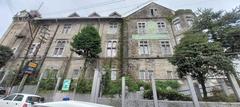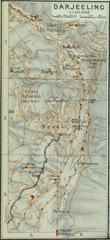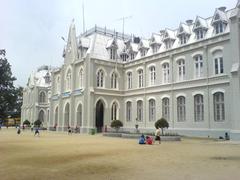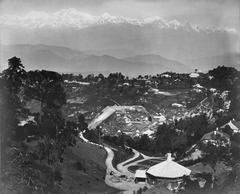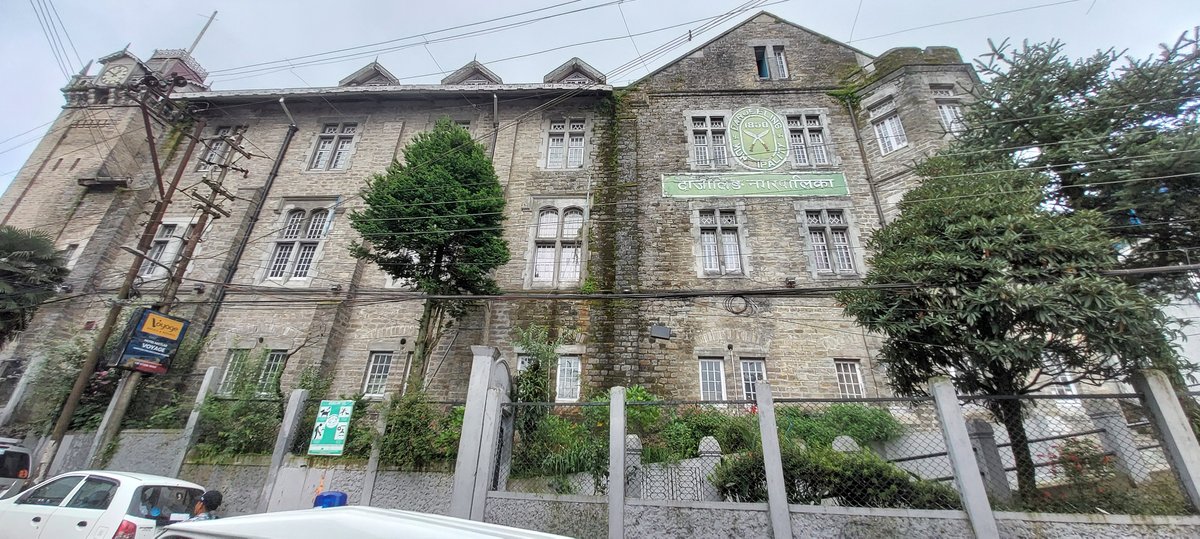
Darjeeling Municipality Visiting Guide: History, Tickets, Hours, and Tips for Tourists
Date: 15/06/2025
Introduction
Nestled in the foothills of the Eastern Himalayas, Darjeeling Municipality—situated in Darjeeling, India—offers a captivating blend of history, culture, and natural beauty. Known as the “Queen of the Hills,” Darjeeling has evolved from its early days as territory of the Kingdom of Sikkim, through British colonial development, into a modern hub famed for its tea estates and panoramic mountain views. The municipality, established in 1850, stands as one of West Bengal’s oldest, encapsulating colonial architecture and serving as the heart of civic administration (darjeeling.gov.in/history; Navrang India).
Darjeeling is more than an administrative center—it’s a cultural mosaic shaped by Lepcha, Bhutia, Nepali, Tibetan, and British influences. Its festivals, cuisine, markets, and UNESCO-listed Darjeeling Himalayan Railway draw visitors seeking immersive Himalayan experiences. This guide provides a detailed overview, including historical evolution, key attractions, visiting hours, ticketing, accessibility, travel tips, and sustainable tourism recommendations (Holiday Landmark; darjeelingtourism.in; Outlook Traveller; TravelSetu).
Table of Contents
- Introduction
- History of Darjeeling: Sikkimese Roots to Colonial Era
- Rise of Darjeeling as a Hill Station and Tea Capital
- Municipal Formation and Governance
- Visiting Hours, Tickets & Accessibility
- Key Attractions and Nearby Sites
- Darjeeling Municipality Building: Heritage & Architecture
- Cultural Landscape, Festivals, and Cuisine
- Practical Visitor Information
- Conservation Challenges & Responsible Tourism
- Frequently Asked Questions (FAQ)
- Visual & Interactive Resources
- Conclusion
- References
History of Darjeeling: Sikkimese Roots to Colonial Era
Darjeeling’s early history is intertwined with the Kingdom of Sikkim, Nepal, Bhutan, and Bengal. The name “Darjeeling” derives from Tibetan “dorje” (thunderbolt) and “ling” (place), meaning “the land of the thunderbolt” (darjeeling.gov.in/history). The area was sparsely populated and saw shifting control until the British East India Company acquired it in 1835, intending to develop a sanatorium for colonial officials. Dr. Archibald Campbell and Lieutenant Napier were instrumental in establishing the early hill station, with road construction beginning in 1839 (en.wikipedia.org/wiki/History_of_Darjeeling).
Rise of Darjeeling as a Hill Station and Tea Capital
With its cool climate and fertile terrain, Darjeeling saw the introduction of tea cultivation in 1841, which flourished into a global industry. The town’s expansion was further enabled by the Treaty of Sinchula (1865) and the opening of the Darjeeling Himalayan Railway in 1881, making it a sought-after destination for British officials and tourists (en.wikipedia.org/wiki/History_of_Darjeeling).
Municipal Formation and Governance
Darjeeling Municipality, founded in 1850, is one of the earliest in West Bengal (en.wikipedia.org/wiki/Darjeeling_Municipality). It initially had nominated commissioners, transitioning to elected governance by 1964. The municipality operates under the West Bengal Municipal Act, 1993, with a Chairman-in-Council and 32 elected councillors, overseeing urban planning, sanitation, water supply, road maintenance, and heritage conservation (gurukuljournal.com).
Visiting Hours, Tickets & Accessibility
Major Historical Sites
-
Darjeeling Himalayan Railway (Toy Train)
- Hours: Daily, Joy Ride from 10 AM–4 PM. Schedules may vary; check IRCTC.
- Tickets: Book at the station or online. Advance booking is advised.
-
Padmaja Naidu Himalayan Zoological Park
- Hours: 9:30 AM–4:30 PM daily.
- Tickets: INR 30 (Indians), INR 100 (foreigners).
-
Himalayan Mountaineering Institute
- Hours: 9 AM–5 PM; closed Mondays.
- Tickets: INR 20–50.
-
Happy Valley Tea Estate
- Hours: 10 AM–4 PM; guided tours available.
- Tickets: Tour fees apply; book in advance.
-
Tiger Hill
- Hours: 4 AM–9 AM (for sunrise views).
- Tickets: Free entry.
-
Batasia Loop
- Hours: 7 AM–6 PM.
- Tickets: Free entry.
Accessibility
Darjeeling’s hilly terrain can be challenging for those with mobility issues. While central areas like Chowrasta are walkable, many sites have steep paths. Contact attractions ahead for accessibility details.
Key Attractions and Nearby Sites
- Chowrasta (Mall Road): Central square with shopping, cafes, and scenic views.
- Japanese Peace Pagoda & Ghoom Monastery: Reflect religious diversity and offer tranquil settings.
- Tea Gardens: Guided tours and tastings at estates like Happy Valley.
- Adventure: Trekking (Singalila National Park), river rafting, and paragliding.
Local markets offer handicrafts, Tibetan jewelry, and regional cuisine. Use registered taxis or shared jeeps for travel; best visiting months are March–May and October–November.
Darjeeling Municipality Building: Heritage & Architecture
The Darjeeling Municipality Building, established in 1850 and constructed by Raj Sahib Kharga Bahadur Chettri, is a striking example of colonial-era architecture. Its arched windows, stone columns, and wide verandahs reflect both British and indigenous influences. The Capital Hall, completed in 1921 with support from the Maharaja of Cooch Behar, is a notable civic venue (Navrang India).
Visiting Information
- Hours: 10 AM–5 PM, Monday to Friday (closed weekends and public holidays).
- Entry: No fee for exterior/public areas; guided heritage walks may include the building.
- Accessibility: Contact ahead for support if mobility is a concern.
Located centrally near Chowrasta, the building is easily accessible by foot or taxi. Combine your visit with nearby attractions like the Himalayan Railway and Chowrasta.
Cultural Landscape, Festivals, and Cuisine
Darjeeling’s vibrant culture is reflected in its festivals—Losar, Buddha Jayanti, Dashain, Tihar, and the Darjeeling Carnival—which feature processions, music, and traditional foods (Holiday Landmark). The town’s population is a mix of Lepcha, Bhutia, Nepali, Tibetan, and Bengali communities, each contributing to a rich tapestry of languages, crafts, and religious sites.
Local cuisine includes momos, thukpa, phagshapa, and of course, world-renowned Darjeeling tea. Shopping for handicrafts, shawls, and Tibetan artifacts along Mall Road is recommended.
Practical Visitor Information
Getting There
- By Rail: New Jalpaiguri (NJP) is the nearest major station, 70 km away; connect via Toy Train or taxi.
- By Air: Bagdogra Airport (IXB), 68 km away; regular flights from major Indian cities.
- Local Transport: Taxis, shared jeeps, and rickshaws are common.
Accommodation
A range of options exists—from luxury hotels to budget homestays. Book in advance during peak seasons (Outlook Traveller). Rural homestays in villages like Sittong offer deeper cultural engagement.
Health & Safety
- Acclimatize to the altitude, stay hydrated, and avoid strenuous activity at first.
- Dress in layers; weather can be unpredictable.
- Carry cash for rural areas; ATMs are available in town.
Local Etiquette
Respect religious sites, dress modestly, and ask before photographing people. English, Hindi, and Nepali are widely spoken.
Conservation Challenges & Responsible Tourism
Darjeeling faces overtourism, infrastructure strain, waste management issues, and environmental degradation (Outlook Traveller). Vertical hotel expansion, water shortages, and deforestation are pressing concerns.
How to Travel Responsibly:
- Choose eco-friendly accommodations and operators.
- Minimize waste; avoid single-use plastics.
- Support local artisans and respect cultural norms.
- Visit during off-peak seasons if possible.
Sustainable tourism initiatives—such as rural homestays and ecotourism programs—are being developed to distribute visitor numbers and protect the ecosystem.
Frequently Asked Questions (FAQ)
Q: What are the hours for the Darjeeling Himalayan Railway?
A: Joy Ride operates 10 AM–4 PM; check seasonal schedules.
Q: How can I buy tickets for the Toy Train?
A: Book online via IRCTC or at the station; advance booking is recommended.
Q: Are tea estate tours available?
A: Yes; guided tours at estates like Happy Valley are best booked in advance.
Q: Is Darjeeling accessible for people with mobility issues?
A: Some central areas are accessible, but the terrain is steep; check with sites ahead.
Q: When is the best time to visit?
A: March–May and October–November for pleasant weather and clear views.
Visual & Interactive Resources
- High-quality images with alt tags (e.g., “Darjeeling Himalayan Railway winding through hills,” “Tea gardens at sunrise”).
- Interactive maps for attractions and walking routes.
- Links to virtual tours and the official tourism website.
Conclusion
Darjeeling Municipality is an extraordinary destination where history, culture, and nature intersect. From its colonial-era architecture to bustling markets, panoramic viewpoints, and vibrant festivals, Darjeeling offers a multifaceted travel experience. By planning ahead and traveling responsibly, you contribute to preserving this Himalayan gem for future generations.
For the latest updates, itinerary planning, and responsible tourism tips, download the Audiala app and consult official tourism channels. Embark on your Darjeeling adventure today!
References and Further Reading
- darjeeling.gov.in/history
- Navrang India
- Holiday Landmark
- darjeelingtourism.in
- Outlook Traveller
- TravelSetu
- Darjeeling District Administration
- Indianetzone
- VillageInfo
- Yaron Ki Sawari
- Safety Visit
- Nature Travel Agency
